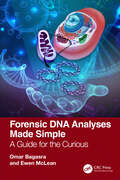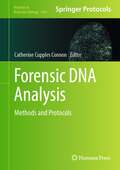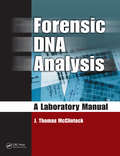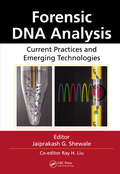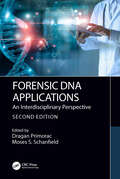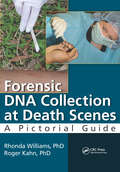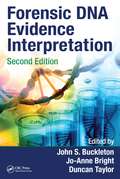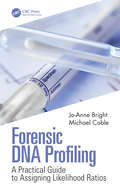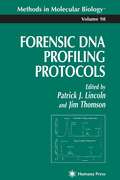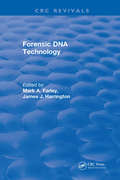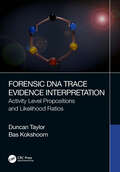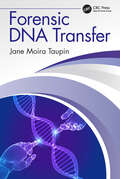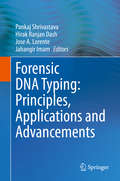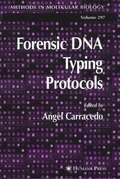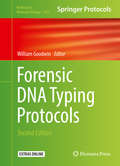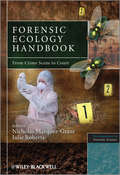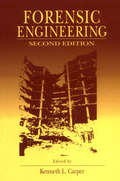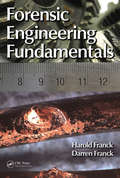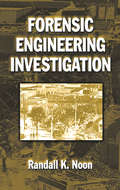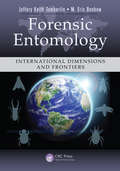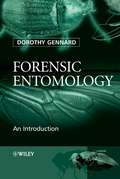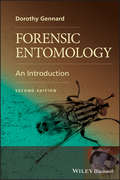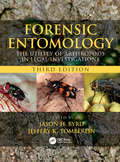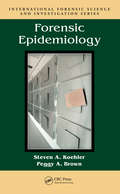- Table View
- List View
Forensic DNA Analyses Made Simple: A Guide for the Curious
by Omar Bagasra Ewen McLeanSequencing genetic material is now common practice. The general population have become consumers of this information but without an understanding of the biological processes that render sequencing data useful. The interpretation of genetic sequence depends on an appreciation of the basics of genetics and the limits of such data. This book provides the background necessary to understand, interpret, and apply sequencing information to real- world problems. Replication of genetic material, the structure of DNA, typing methods, and forensic applications are all discussed in this useful primer. Key Features • Provides self-learning about DNA fingerprinting. • Includes sections on how to analyze and interpret DNA fingerprinting. • Covers legal and medicolegal issues and case analyses. • Teaches novice legal community about DNA fingerprints. • Summarizes for a general audience the role of ancestry, DNA, and what that means.
Forensic DNA Analysis: Methods and Protocols (Methods in Molecular Biology #2685)
by Catherine Cupples ConnonThis volume focuses on the latest techniques used in forensic DNA analysis. The chapters include a comprehensive collection of extraction, quantification, STR amplification, and detection methods for routine forensic samples, including manual, semi-automated, and automated procedures using both home-brew and commercial products. The chapters also discuss probabilistic modeling software and specialized start-to-finish procedures for mitochondrial DNA analysis, archived latent fingerprints, latent DNA, rapid DNA profiling, and next-generation sequencing. Written in the highly successful Methods in Molecular Biology series format, chapters include introduction to their respective topics, lists of the necessary materials and reagents, step-by-step, readily reproducible laboratory protocols, and tips on troubleshooting and avoiding known pitfalls.Cutting-edge and practical, Forensic DNA Analysis: Methods and Protocols is a valuable resource for researchers interested in learning more about forensic DNA analysis procedures.
Forensic DNA Analysis: A Laboratory Manual
by J. Thomas McClintockIn its short but active history, the use of DNA typing has revolutionized criminal investigations. It is almost inconceivable to bring a case to trial without positive identification through what is now our most accurate means. Proficiency with the methodology, principles, and interpretation of DNA evidence is crucial for today‘s criminalist.
Forensic DNA Analysis: Current Practices and Emerging Technologies
by Jaiprakash G. ShewaleThe field of forensic DNA analysis has grown immensely in the past two decades and genotyping of biological samples is now routinely performed in human identification (HID) laboratories. Application areas include paternity testing, forensic casework, family lineage studies, identification of human remains, and DNA databasing. Forensic DNA Analysis:
Forensic DNA Applications: An Interdisciplinary Perspective
by Dragan Primorac and Moses S. SchanfieldForensic DNA Applications: An Interdisciplinary Perspective, Second Edition is fully updated to outline the latest advances in forensic DNA testing techniques and applications. It continues to fill the need for a reference book for people working in the field of forensic molecular biology testing and research as well as individuals investigating and adjudicating cases involving DNA evidence, whether they be civil or criminal cases. DNA techniques have greatly impacted obvious traditional forensic areas, but such advances have also positively affected myriad new areas of research and inquiry. It is possible today to think about solving forensic problems that were simply unheard of even a few years ago. As such, the book pulls all relevant research and applied science together into a detailed and comprehensive collection. Part I begins with the history and development of DNA typing and profiling for criminal and civil purposes. It discusses the statistical interpretation of results with case examples, mitochondrial DNA testing, Y single nucleotide polymorphisms (SNPs) and short tandem repeats (STRs), and X SNP and STR testing. It also explores low copy number DNA typing, mixtures, and quality assurance and control. Part II moves on to cover the various uses and applications of analyzing collected physical evidence, victim identification in mass disasters, analyzing animal DNA, forensic botany, and other unique applications. Part III is dedicated to the latest advances and developments in human molecular biology and Part IV looks at policies and laws and ethics governing DNA evidence, and its utilization in various cases and the courts. Forensic DNA Applications, Second Edition covers cutting-edge research and advancements in the field and is the most up-to-date reference available. Edited and contributed to by the world's foremost leaders in the field, it is a must-have reference for established professionals, and an essential resource to legal professionals—lawyers and judges dealing with civil and criminal cases involving DNA technology—as well as students entering the fields of genetics and forensic DNA analysis.
Forensic DNA Collection at Death Scenes: A Pictorial Guide
by Rhonda Williams PhD F-ABC Roger Kahn PhD. F-ABCDNA evidence collected from death scenes is an essential tool for law enforcement, death investigators, and forensic pathologists providing insights into cause and manner of death as well as the identification of the responsible person or persons. Ineffective collection procedures raise the risk of evidence being altered or lost during transportati
Forensic DNA Evidence Interpretation
by John S. Buckleton Jo-Anne Bright Duncan TaylorNow in its second edition, Forensic DNA Evidence Interpretation is the most comprehensive resource for DNA casework available today. Written by leaders in the fields of biology and statistics, including a contribution from Peter Gill, the father of DNA analysis, the book emphasizes the interpretation of test results and provides the necessary formulae in an easily accessible manner. This latest edition is fully updated and includes current and emerging techniques in this fast-moving field. The book begins by reviewing all pertinent biology, and then provides information on every aspect of DNA analysis. This includes modern interpretation methods and contemporary population genetic models available for estimating DNA frequencies or likelihood ratios. Following a chapter on procedures for validating databases, the text presents overviews and performance assessments of both modern sampling uncertainty methods and current paternity testing techniques, including new guidelines on paternity testing in alignment with the International Society for Forensic Genetics. Later chapters discuss the latest methods for mixture analysis, LCN (ultra trace) analysis and non-autosomal (mito, X, and Y) DNA analysis. The text concludes with an overview of procedures for disaster victim identification and information on DNA intelligence databases. Highlights of the second edition include: New information about PCR processes, heterozygote balance and back and forward stuttering New information on the interpretation of low template DNA, drop models and continuous models Additional coverage of lineage marker subpopulation effects, mixtures and combinations with autosomal markers This authoritative book provides a link among the biological, forensic, and interpretative domains of the DNA profiling field. It continues to serve as an invaluable resource that allows forensic scientists, technicians, molecular biologists and attorneys to use forensic DNA evidence to its greatest potential.
Forensic DNA Evidence Interpretation
by John S. Buckleton, Jo-Anne Bright and Duncan TaylorNow in its second edition, Forensic DNA Evidence Interpretation is the most comprehensive resource for DNA casework available today. Written by leaders in the fields of biology and statistics, including a contribution from Peter Gill, the father of DNA analysis, the book emphasizes the interpretation of test results and provides the necessary formulae in an easily accessible manner. This latest edition is fully updated and includes current and emerging techniques in this fast-moving field. The book begins by reviewing all pertinent biology, and then provides information on every aspect of DNA analysis. This includes modern interpretation methods and contemporary population genetic models available for estimating DNA frequencies or likelihood ratios. Following a chapter on procedures for validating databases, the text presents overviews and performance assessments of both modern sampling uncertainty methods and current paternity testing techniques, including new guidelines on paternity testing in alignment with the International Society for Forensic Genetics. Later chapters discuss the latest methods for mixture analysis, LCN (ultra trace) analysis and non-autosomal (mito, X, and Y) DNA analysis. The text concludes with an overview of procedures for disaster victim identification and information on DNA intelligence databases.Highlights of the second edition include: New information about PCR processes, heterozygote balance and back and forward stuttering New information on the interpretation of low template DNA, drop models and continuous models Additional coverage of lineage marker subpopulation effects, mixtures and combinations with autosomal markers This authoritative book provides a link among the biological, forensic, and interpretative domains of the DNA profiling field. It continues to serve as an invaluable resource that allows forensic scientists, technicians, molecular biologists and attorneys to use forensic DNA evidence to its greatest potential.
Forensic DNA Profiling: A Practical Guide to Assigning Likelihood Ratios
by Jo-Anne Bright Michael CobleDNA testing and its forensic analysis are recognized as the “gold standard” in forensic identification science methods. However, there is a great need for a hands-on step-by-step guide to teach the forensic DNA community how to interpret DNA mixtures, how to assign a likelihood ratio, and how to use the subsequent likelihood ratio when reporting interpretation conclusions. Forensic DNA Profiling: A Practical Guide to Assigning Likelihood Ratios will provide a roadmap for labs all over the world and the next generation of analysts who need this foundational understanding. The techniques used in forensic DNA analysis are based upon the accepted principles of molecular biology. The interpretation of a good-quality DNA profile generated from a crime scene stain from a single-source donor provides an unambiguous result when using the most modern forensic DNA methods. Unfortunately, many crime scene profiles are not single source. They are described as mixed since they contain DNA from two or more individuals. Interpretation of DNA mixtures represents one of the greatest challenges to the forensic DNA analyst. As such, the book introduces terms used to describe DNA profiles and profile interpretation. Chapters explain DNA extraction methods, the polymerase chain reaction (PCR), capillary electrophoresis (CE), likelihood ratios (LRs) and their interpretation, and population genetic models—including Mendelian inheritance and Hardy-Weinberg equilibrium. It is important that analysts understand how LRs are generated in a probabilistic framework, ideally with an appreciation of both semicontinuous and fully continuous probabilistic approaches. KEY FEATURES:• The first book to focus entirely on DNA mixtures and the complexities involved with interpreting the results • Takes a hands-on approach offering theory with worked examples and exercises to be easily understood and implementable by laboratory personnel • New methods, heretofore unpublished previously, provide a means to innovate deconvoluting a mixed DNA profile, assign an LR, and appropriately report the weight of evidence • Includes a chapter on assigning LRs for close relatives (i.e., “It’s not me, it was my brother”), and discusses strategies for the validation of probabilistic genotyping software Forensic DNA Profiling fills the void for labs unfamiliar with LRs, and moving to probabilistic solutions, and for labs already familiar with LRs, but wishing to understand how they are calculated in more detail. The book will be a welcome read for lab professionals and technicians, students, and legal professionals seeking to understand and apply the techniques covered.
Forensic DNA Profiling Protocols
by Patrick J. LincolnLeading forensic experts from around the world describe in detail their time-proven methods for identity testing through DNA analysis. Their state-of-the-art collection of easily reproducible methods includes all of the major techniques of DNA analysis currently used in forensic identity testing. The book covers PCR- based test systems, the now widely used STR typing systems (complete with details of both manual and automated detection systems), repeat unit mapping (MVR), direct phase minisequencing, capillary electrophoresis, and direct blotting. Also fully discussed are the recovery of DNA from a wide range of sample types (blood, semen, skeletal remains, and saliva), species testing, sex determination, and mitochondrial DNA testing. This state-of-the-art collection of easily reproducible methods includes all of the major techniques of DNA analysis currently used in forensic identity testing. The methods include the recovery of DNA from a large range of sample types, analysis of DNA as single and multi-locus VNTR probes, PCR amplification of STR and other loci, and mitochondrial sequencing. The expert scientists writing here-many from laboratories around the world-also discuss how to interpret the results in cases of unknown identity and disputed parentage.
Forensic DNA Technology
by Mark A. FarleyForensic DNA Technology examines the legal and scientific issues relating to the implementation of DNA print technology in both the crime laboratory and the courtroom. Chapters have been written by many of the country's leading experts and trace the underlying theory and historical development of this technology, as well as the methodology utilized in the Restriction Fragment Length Polymorphism (RFLP) and Polymerase Chain Reaction (PCR) techniques. The effect of environmental contaminants on the evidence and the statistical analysis of population genetics data as it relates to the potential of this technology for individualizing the donor of the questioned sample are also addressed. Other topics include the proposed guidelines for using this technology in the crime laboratory, the perspective of the prosecution and the defense, the legal standards for determining the admissibility and weight of such evidence at trial. Finally, the issues of validation and the standards for interpretation of autoradiograms are brought into focus in a detailed study of actual case work. Forensic scientists, prosecuting attorneys, defense attorneys, libraries, and all scientists working with DNA technology should consider this a "must have" book.
Forensic DNA Trace Evidence Interpretation: Activity Level Propositions and Likelihood Ratios
by Duncan Taylor Bas KokshoornForensic DNA Trace Evidence Interpretation: Activity Level Propositions and Likelihood Ratios provides all foundational information required for a reader to understand the practice of evaluating forensic biology evidence given activity level propositions and to implement the practice into active casework within a forensic institution. The book begins by explaining basic concepts and foundational theory, pulling together research and studies that have accumulated in forensic journal literature over the last 20 years. The book explains the laws of probability - showing how they can be used to derive, from first principles, the likelihood ratio - used throughout the book to express the strength of evidence for any evaluation. Concepts such as the hierarchy of propositions, the difference between experts working in an investigative or evaluative mode and the practice of case assessment and interpretation are explained to provide the reader with a broad grounding in the topics that are important to understanding evaluation of evidence. Activity level evaluations are discussed in relation to biological material transferred from one object to another, the ability for biological material to persist on an item for a period of time or through an event, the ability to recover the biological material from the object when sampled for forensic testing and the expectations of the prevalence of biological material on objects in our environment. These concepts of transfer, persistence, prevalence and recovery are discussed in detail in addition to the factors that affect each of them. The authors go on to explain the evaluation process: how to structure case information and formulate propositions. This includes how a likelihood ratio formula can be derived to evaluate the forensic findings, introducing Bayesian networks and explaining what they represent and how they can be used in evaluations and showing how evaluation can be tested for robustness. Using these tools, the authors also demonstrate the ways that the methods used in activity level evaluations are applied to questions about body fluids. There are also chapters dedicated to reporting of results and implementation of activity level evaluation in a working forensic laboratory. Throughout the book, four cases are used as examples to demonstrate how to relate the theory to practice and detail how laboratories can integrate and implement activity level evaluation into their active casework.
Forensic DNA Transfer
by Jane Moira TaupinForensic DNA Transfer provides a guide to the recognition and current understanding of DNA transfer in forensic criminal investigations. Increased improvements in technology mean that it is now routinely possible to obtain DNA profiles from non-visible deposits. How or when the DNA in question was deposited may be an issue in the context of the case, especially if the donor of the DNA is not in dispute. A DNA profile alone cannot reveal when or how that DNA was deposited at a crime scene, nor can it reveal the body matter from which it originated. Issues of transfer associated with activities may be debated – which the traditional discrimination purpose of DNA profiling cannot address. DNA may be everywhere and anywhere – in homes, at workplaces, during transport, and on personal items including clothing. DNA from a person may be on an object they have never contacted or in a room they have never entered. Concepts discussed in the book include non-self DNA on hands through day-to-day activities, the prevalence of background DNA in the environment and perhaps on the exhibit, the persistence of any DNA transferred, and that a DNA result will depend on these variables as well as recovery techniques. Since DNA may be transferred to an exhibit: (a) during the commission of a crime, (b) before the crime, and/or (c) after the crime through handling, examination, and testing, this book covers various transfer pathways and sources of DNA. Inadvertent issues of transfer of DNA resulting in wrongful convictions and the misleading of investigations are discussed, with an emphasis on contamination mitigation. Forensic DNA Transfer examines the additional complexity resulting from non-visible deposits of DNA that impact on sampling and testing regimes. The changing understanding of the composition of purported 'touch DNA' deposits from the skin, including extracellular DNA transported via body secretions is described. Further, the newer focus on interpreting DNA evidence – using activity level propositions and the rationale and associated issues – is also discussed.
Forensic DNA Typing: Principles, Applications and Advancements
by Pankaj Shrivastava Hirak Ranjan Dash Jose A. Lorente Jahangir ImamThe book explores the fundamental principles, advances in forensic techniques, and its application on forensic DNA analysis. The book is divided into three modules; the first module provides the historical prospect of forensic DNA typing and introduces fundamentals of forensic DNA typing, methodology, and technical advancements, application of STRs, and DNA databases for forensic DNA profile analysis. Module 2 examines the problems and challenges encountered in extracting DNA and generating DNA profiles. It provides information on the methods and the best practices for DNA isolation from forensic biological samples and human remains like ancient DNA, DNA typing of skeletal remains and disaster victim identification, the importance of DNA typing in human trafficking, and various problems associated with capillary electrophoresis. Module 3 emphasizes various technologies that are based on SNPs, STRs namely Y-STR, X-STR, mitochondrial DNA profiling in forensic science. Module 4 explores the application of non-human forensic DNA typing of domestic animals, wildlife forensics, plant DNA fingerprinting, and microbial forensics. The last module discusses new areas and alternative methods in forensic DNA typing, including Next-Generation Sequencing, and its utility in forensic science, oral microbes, and forensic DNA phenotyping. Given its scope, the book is a useful resource in the field of DNA fingerprinting for scientists, forensic experts, and students at the postgraduate level.
Forensic DNA Typing Protocols
by Angel CarracedoA state-of-the-art collection of readily reproducible laboratory methods for DNA identity analysis, including Y chromosome haplotyping, mtDNA, and SNP typing. The book offers well-tested protocols for DNA quantification using real-time PCR on forensic samples and for the determination of the number of amelogenine gene copies. For forensic geneticists, there are readily reproducible methods for species identification, ancient DNA, and pharmacogenetics. Additional chapters address new applications in the forensic genetics lab, such a species identification or typing of CYP polymorphisms for the analysis of adverse to drugs.
Forensic DNA Typing Protocols
by William GoodwinThisvolume presents a series of protocols and methods, some of which are not widelyused by researchers/practitioners, and will aid in the execution of differentlaboratory techniques. Forensic DNA Typing Protocols, Second Edition isarranged into a series of related chapters. Chapter 1-3 examines two differentaspects of RNA analysis for body fluid identification. Chapters 4-7 focuses onthe storage of biological materials and the extraction of DNA from hardtissues. Chapters 8-10 present methods for monitoring the quality of DNAextracts, and steps to aid in the purification of DNA. Chapters 11-16 talkabout methods on non-standard markers, such as INDELs, Y chromosome STRs, andmitochondrial DNA. Detailed procedures and data analysis for phenotypes andancestry are explored in Chapter 17-19. The last chapter (20) looks at theapplication of DNA typing to the identification of non-human material tospecies level. Written in the highly successful Methods in Molecular Biologyseries format, chapters include introductions to their respective topics,lists of the necessary materials and reagents, step-by-step, readilyreproducible laboratory protocols, and tips on troubleshooting and avoidingknown pitfalls. Practical and thorough, Forensic DNA Typing Protocols, Second Edition, isa valuable resource for forensic specialists, researchers, and anyoneinterested in the field of forensic science.
Forensic Ecology Handbook
by Nicholas Márquez-Grant Julie RobertsThe analysis of plants, insects, soil and other particulates from scenes of crime can be vital in proving or excluding contact between a suspect and a scene, targeting search areas, and establishing a time and place of death. Forensic Ecology: A Practitioner's Guide provides a complete handbook covering all aspects of forensic ecology. Bringing together the forensic applications of anthropology, archaeology, entomology, palynology and sedimentology in one volume, this book provides an essential resource for practitioners in the field of forensic science, whether crime scene investigators, forensic science students or academics involved in the recovery and analysis of evidence from crime scenes.Forensic Ecology: A Practitioner's Guide includes information not only on the search, location, recovery and analysis of evidence, but includes sampling strategies for diatom analysis, pollen and soils samples and entomology and provides guides for good practice. Each chapter provides background information on each discipline and is structured according to pre-scene attendance (what questions should the scientist ask when receiving a call? What sort of preparation is required?), scene attendance (including protocols at the scene, sampling strategies, recording), scientific examination of analysis of the evidence up to the stages and guidelines for witness statement and presenting evidence in court.The book is written by specialists in all fields with a wealth of experience who are current forensic practitioners around the world. It provides an essential and accessible resource for students, academics, forensic practitioners and police officers everywhere.
Forensic Engineering
by Kenneth L. CarperThis edition of Forensic Engineering updates the original work with new case studies and investigative techniques. Contributors to the book are the foremost authorities in each area of specialization. These specialty areas include fire investigation, industrial accidents, product liability, traffic accidents, civil engineering and transportation di
Forensic Engineering Fundamentals
by Harold Franck Darren FranckForensic engineers often specialize in a particular area such as structures, fires, or accident reconstruction. However, the nature of the work often requires broad knowledge in the interrelated areas of physics, chemistry, biomechanics, and engineering. Covering cases as varied as assessment of workplace accidents to the investigation of Halliburt
Forensic Engineering Investigation
by Randall K. NoonForensic Engineering Investigation is a compendium of the investigative methodologies used by engineers and scientific investigators to evaluate some of the more common types of failures and catastrophic events. In essence, the book provides analyses and methods for determining how an entity was damaged and when that damage may have legal consequen
Forensic Entomology: International Dimensions and Frontiers (Contemporary Topics in Entomology)
by M. Eric Benbow Jeffery Keith TomberlinThe use of forensic entomology has become established as a global science. Recent efforts in the field bridge multiple disciplines including, but not limited to, microbiology, chemistry, genetics, and systematics as well as ecology and evolution. The first book of its kind, Forensic Entomology: International Dimensions and Frontiers provides an inc
Forensic Entomology: An Introduction
by Dorothy GennardThis invaluable text provides a concise introduction to entomology in a forensic context and is also a practical guide to collecting entomological samples at the crime scene. Forensic Entomology: An Introduction: Assumes no prior knowledge of either entomology or biology Provides background information about the procedures carried out by the professional forensic entomologist in order to determine key information about post-mortem interval presented by insect evidence Includes practical tasks and further reading to enhance understanding of the subject and to enable the reader to gain key laboratory skills and a clear understanding of insect life cycles, the identification features of insects, and aspects of their ecology Glossary, photographs, the style of presentation and numerous illustrations have been designed to assist in the identification of insects associated with the corpse; keys are included to help students make this identification This book is an essential resource for undergraduate Forensic Science and Criminology students and those on conversion postgraduate M.Sc. courses in Forensic Science. It is also useful for Scenes of Crime Officers undertaking diploma studies and Scene Investigating Officers.
Forensic Entomology
by Dorothy GennardThis invaluable text provides a concise introduction to entomology in a forensic context and is also a practical guide to collecting entomological samples at the crime scene.Forensic Entomology: An Introduction:Assumes no prior knowledge of either entomology or biologyProvides background information about the procedures carried out by the professional forensic entomologist in order to determine key information about post-mortem interval presented by insect evidenceIncludes practical tasks and further reading to enhance understanding of the subject and to enable the reader to gain key laboratory skills and a clear understanding of insect life cycles, the identification features of insects, and aspects of their ecologyGlossary, photographs, the style of presentation and numerous illustrations have been designed to assist in the identification of insects associated with the corpse; keys are included to help students make this identificationThis book is an essential resource for undergraduate Forensic Science and Criminology students and those on conversion postgraduate M.Sc. courses in Forensic Science. It is also useful for Scenes of Crime Officers undertaking diploma studies and Scene Investigating Officers.
Forensic Entomology: The Utility of Arthropods in Legal Investigations, Third Edition
by Jason H. Byrd; Jeffery K. TomberlinForensic Entomology: The Utility of Arthropods in Legal Investigations, Third Edition continues in the tradition of the two best-selling prior editions and maintains its status as the single-most comprehensive book on Forensic Entomology currently available. It includes current, in-the-field best practices contributed by top professionals in the field who have advanced it through research and fieldwork over the last several decades. The use of entomology in crime scene and forensic investigations has never been more prevalent or useful given the work that can be done with entomological evidence. The book recounts briefly the many documented historical applications of forensic entomology over several thousand years. Chapters examine the biological foundations of insect biology and scientific underpinnings of forensic entomology, the principles that govern utilizing insects in legal and criminal investigations. The field today is diverse, both in topics studied, researched and practiced, as is the field of professionals that has expanded throughout the world to become a vital forensic sub-discipline. Forensic Entomology, Third Edition celebrates this diversity by including several new chapters by premier experts in the field that covers such emerging topics as wildlife forensic entomology, microbiomes, urban forensic entomology, and larval insect identification, many of which are covered in depth for the first time. The book will be an invaluable reference for investigators, legal professionals, researchers, practicing and aspiring forensic entomologists, and for the many students enrolled in forensic science and entomology university programs.
Forensic Epidemiology (International Forensic Science and Investigation)
by Steven A. Koehler Peggy A. BrownAfter 9/11, forensic epidemiology emerged as a leading investigative tool, partnering public health officers with law enforcement like never before. Based on the authors first-hand experience, Forensic Epidemiology brings to light the vast amounts of information collected by medical examiners that will be useful in advancing death investigation te
